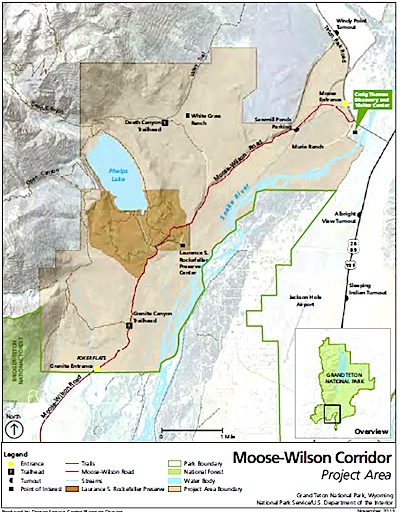
The Moose-Wilson Road in Grand Teton National Park is a thin, two-lane ribbon running through a gorgeous part of the park. It's a particularly scenic way to enter the park, especially in fall when the vegetation is changing colors and the bears come to gorge themselves on ripe berries.
But how should it be managed long-term? That can be a good question in the fall, when the road can become jammed with vehicles and visitors looking to photograph bears, moose, and any other wildlife that appears.
Through February 6 the park is taking input on what should be considered as a comprehensive management plan/environmental impact statement for the Moose-Wilson corridor is developed. The purpose of the document is to determine how best to provide appropriate opportunities for visitors to use, experience, and enjoy the Moose-Wilson area while protecting park resources and values.
During the scoping period, Grand Teton officials are seeking input from the public on significant issues, alternatives, concerns, opportunities, or topics that should be addressed during the planning effort. The Plan/EIS will consider a range of alternatives for the corridor’s future management and will analyze potential environmental impacts associated with each alternative. Additional opportunities for public involvement will also be provided at other stages of the planning process.
The Moose-Wilson corridor comprises about 10,300 acres in the southwest corner of Grand Teton National Park. This exceptional area has a remarkable variety of natural communities, cultural and wilderness resources, and opportunities for visitor enjoyment. The Moose – Wilson Road extends 7.7 miles through the area, and is the primary access to several park destinations, including Death Canyon and Granite Canyon trailheads, Laurance S. Rockefeller Preserve, White Grass Ranch, and Murie Ranch historic districts, and Sawmill Ponds overlook.
The corridor highlights the rich history of working ranches and the beginnings of conservation work, and provides exceptional opportunities for wildlife viewing. Developing a comprehensive management plan for the corridor is critical to ensure the protection of key resources, values, and visitor experience for the enjoyment of this and future generations.
An open house on the planning effort is scheduled for January 14 from 5 p.m.-8 p.m. in the Moose-Wapiti Classroom at St. John’s Medical Center in Jackson, Wyoming. Additional information, including a scoping newsletter is available at this site. A copy of the newsletter can be downloaded through that website, and comments can be provided electronically online.

 Support Essential Coverage of Essential Places
Support Essential Coverage of Essential Places







Add comment